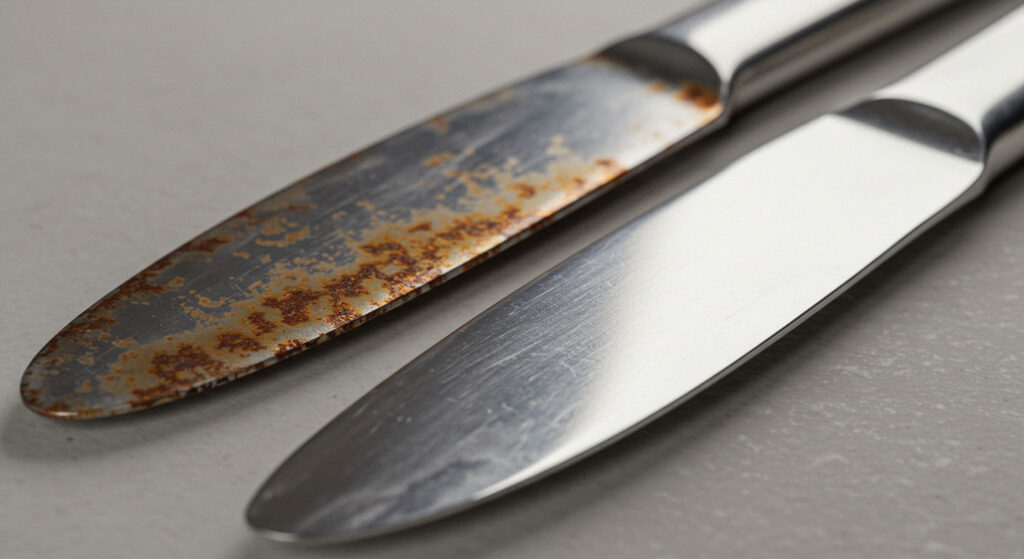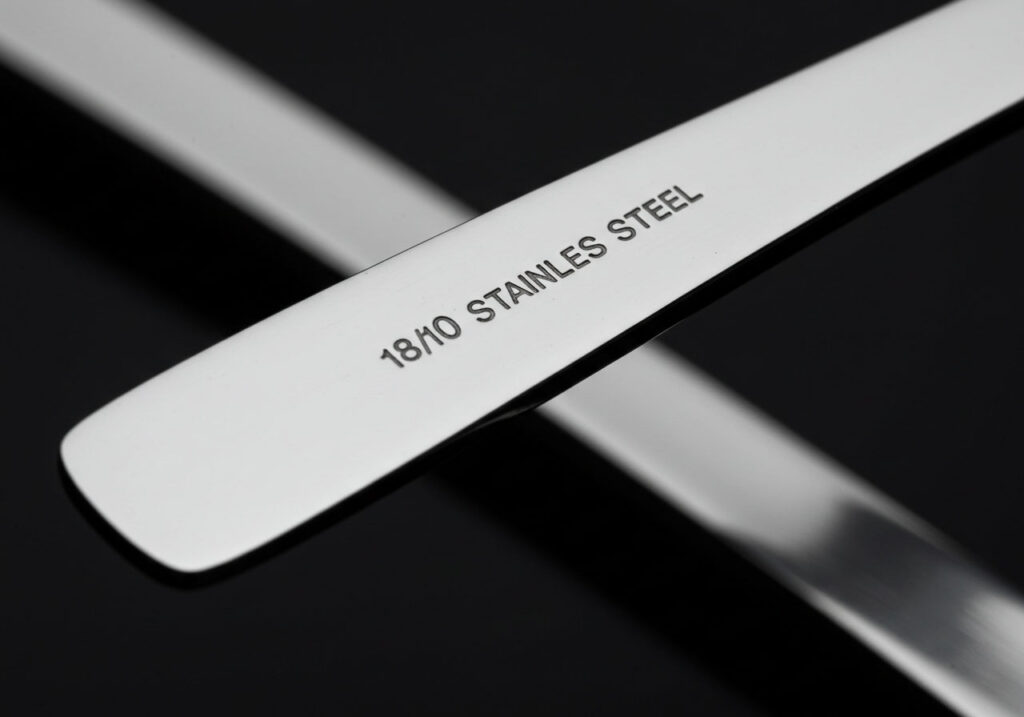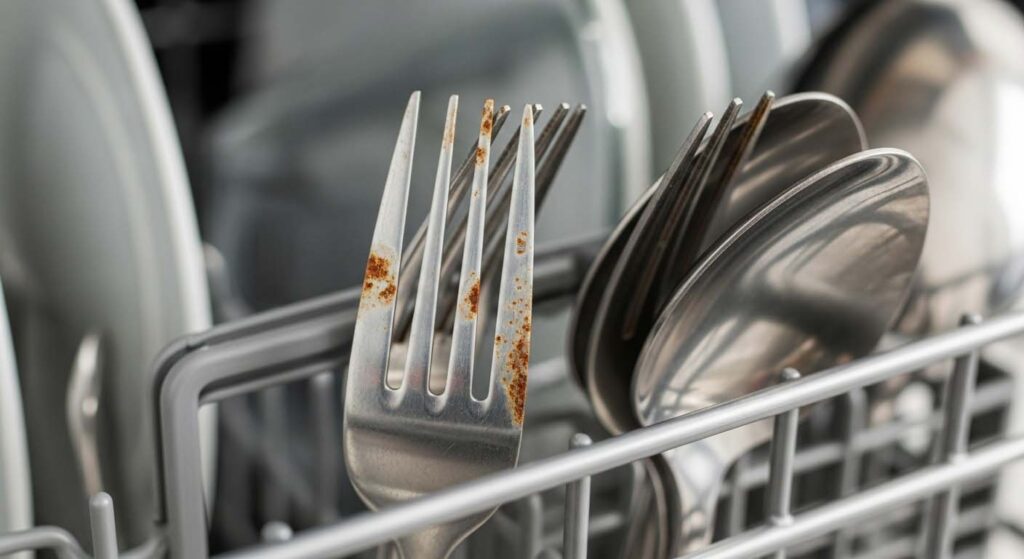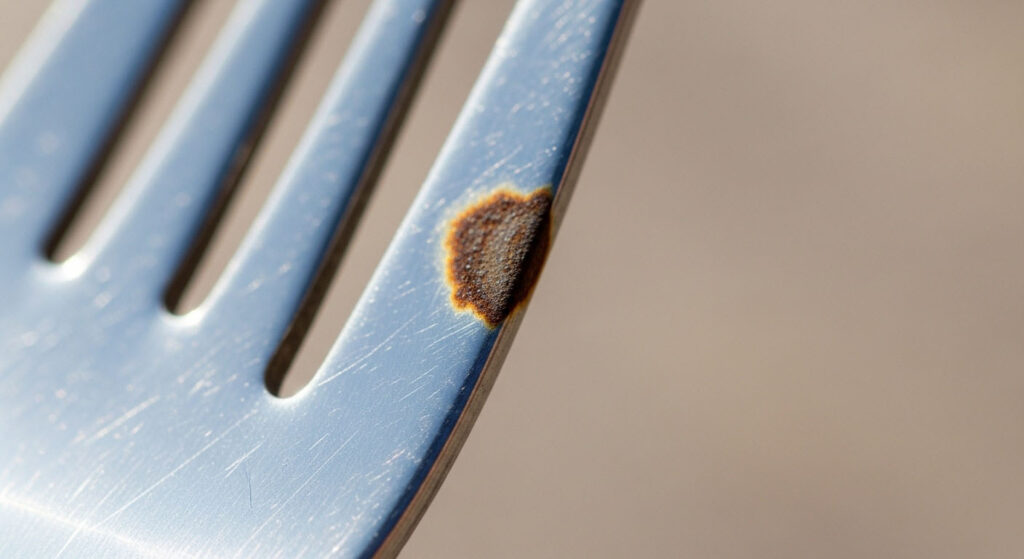How to prevent rust on stainless steel cutlery?
You bought beautiful "stainless" steel cutlery, but now you see ugly orange rust spots. It feels like a betrayal. Your expensive set is ruined, and you're frustrated.
The best way to prevent rust is to choose 18/10 or 18/8 grade stainless steel, hand-dry your cutlery immediately after washing, and avoid leaving it to soak. Also, keep it away from harsh, citrus-based detergents and direct contact with other metals.

It's a shocking sight, isn't it? The word "stainless1" implies it shouldn't stain or rust. I've had many clients, even experienced ones like Jacky who buys cutlery for huge US hotel chains, call me asking why their new flatware has developed rust spots. The truth is, "stainless" doesn't mean "stain-proof." It just means it stains less. All steel can rust under the right (or wrong) conditions. The key is understanding why it happens and how to easily stop it. Let's start by looking at the grades of steel.
What grade stainless steel does not rust?
You want to buy cutlery that will never rust, period. But labels like 18/10, 18/8, and 18/0 are confusing. Choosing wrong means you'll face the same rust problem again.
No stainless steel is 100% rust-proof, but 18/10 and 18/8 grades offer the highest rust resistance. The nickel content (the "10" or "8") creates a protective layer that makes it extremely difficult for rust to form. Grade 18/0, with no nickel, is much more likely to rust.

The name "stainless steel" refers to a family of iron-based alloys. The secret ingredients that fight rust are chromium and nickel. The numbers in the grade, like 18/10, tell you the percentage of these key elements. When I talk with professional buyers, this is the most important technical detail we discuss, as it directly impacts long-term performance and brand reputation. The difference in price between the grades is all about the nickel content, as it's an expensive metal.
Understanding the Numbers
- The "18" (Chromium2): All stainless steel used for cutlery contains around 18% chromium. When chromium is exposed to oxygen, it forms a thin, invisible, passive layer on the steel's surface. This layer is what primarily prevents rust. If it gets scratched, it can "heal" itself as long as oxygen is present.
- The "10" or "0" (Nickel3): This is the game-changer for rust resistance. Nickel significantly boosts the corrosion protection provided by the chromium layer, especially against acids and salts found in food. 18/10 steel contains 10% nickel, making it the king of rust resistance. 18/0 steel has zero nickel, making it far more vulnerable, especially in the humid environment of a dishwasher.
Why is my cutlery going rusty after washing?
Your cutlery looks fine going into the dishwasher but comes out with rust spots. It's incredibly frustrating. You blame the dishwasher, the cutlery, or the detergent.
Rust after washing is usually caused by prolonged exposure to moisture, harsh detergents (especially citrus-based ones), or direct contact with rust-prone metals. Leaving cutlery to air-dry in a humid dishwasher basket is a major cause of these rust spots, known as "pitting corrosion."

The dishwasher is a harsh environment. It's hot, wet, and filled with chemicals for a long time. This is the ultimate stress test for stainless steel. When a client reports rust, I usually walk them through a checklist to find the cause. It's almost always one of a few common culprits. The good news is that they are all easy to fix with small changes to your routine.
Top Dishwasher Mistakes Causing Rust
- Letting It Sit: Leaving cutlery in a wet, steamy dishwasher after the cycle ends is the number one problem. The combination of heat and trapped moisture is the perfect recipe for rust spots. Always remove the cutlery and dry it, or at least open the door to let the steam escape.
- Harsh Detergents: Many modern dishwasher detergents, especially pods and those with bleach or high concentrations of citrus additives, can be very corrosive. They can slowly weaken the steel's protective layer.
- Metal Contact: If your stainless steel cutlery touches a rusty dishwasher rack or a cheap aluminum pan, rust can sometimes transfer. This is a form of galvanic corrosion. Try to keep different types of metals separated.
- Hard Water: High mineral content in your water can leave deposits on your flatware. These spots can trap moisture and eventually lead to rust. Using a rinse aid helps water sheet off more effectively.
How to remove rust from stainless steel?
You've discovered rust spots on your favorite cutlery. You think you have to throw it away. Don't give up! The damage is often just on the surface and easily fixable.
You can remove light surface rust easily. Make a paste of baking soda and water, apply it to the rust spots, and rub gently with a soft cloth. For tougher spots, a bit of white vinegar on a cloth can help dissolve the rust. Always wash and dry thoroughly afterward.

Luckily, most rust you see on cutlery is just surface rust. It hasn't permanently damaged the steel itself. You can fix it with common items you already have in your kitchen. There are two simple, non-toxic methods I recommend to all my customers. The most important rule is to avoid harsh scrubbers like steel wool or abrasive powders, as they will permanently scratch the finish of your cutlery—even more than the rust itself.
Simple Rust Removal Methods
- The Baking Soda Paste Method (Gentle): This should always be your first step.
- Mix baking soda with a few drops of water to form a thick toothpaste-like paste.
- Apply this paste directly onto the rust spots.
- Let it sit for about 30 minutes.
- Use a soft cloth or a non-abrasive sponge to gently rub the area.
- Rinse the cutlery with warm water and dry it immediately with a clean cloth.
- The Vinegar Method (Stronger): If baking soda isn't enough, vinegar's mild acidity works well.
- Dampen a soft cloth with white vinegar.
- Rub the cloth directly onto the rust spot.
- For stubborn spots, you can let the piece soak in vinegar for 5 minutes, but no longer.
- Wash with regular soap and water to remove the vinegar, then dry completely.
Is it safe to use rusty cutlery?
You see a speck of rust on a fork and hesitate. Is it still safe to eat with? The thought of ingesting rust is alarming and can make you want to throw the piece out.
Using cutlery with a tiny bit of rust is generally not harmful. Rust is just hydrated iron oxide, and small amounts are not toxic. However, heavily rusted cutlery can have a metallic taste and a pitted surface that traps bacteria, so it should be cleaned or discarded.

This is a question of both health and hygiene. From a pure health standpoint, the iron oxide that makes up rust isn't going to poison you in small amounts. Our bodies are equipped to handle tiny quantities of it. The real issue is less about toxicity and more about what the rust represents.
Health vs. Hygiene
- Health Risk (Low): Public health organizations agree that accidentally ingesting a small amount of rust is not a cause for concern. The risk of harm is extremely low.
- Hygiene Risk (Moderate): This is the real problem. A rusted surface is no longer smooth; it becomes rough and pitted. These microscopic pits are perfect hiding places for bacteria and germs. Even after washing, germs can remain trapped in the rough surface, which is a much bigger concern than the rust itself.
- Quality Issue: Finally, rust indicates that the stainless steel's protective layer has been compromised in that spot. Once rust starts, that area will continue to rust more easily in the future.
My advice is simple: if you see a spot of rust, clean it off immediately using the methods I described. If the rust is severe and has created deep pits that you can feel, it is best to retire that piece from use.
Conclusion
Prevent rust by buying quality 18/10 or 18/8 steel and always drying it immediately after washing. This simple habit keeps your stainless cutlery looking perfect for a lifetime.
-
Understanding the properties of stainless steel can help you choose the right materials and maintain them effectively. ↩
-
Understanding chromium's role in cutlery can enhance your knowledge of rust resistance and material quality. ↩
-
Understanding nickel's role in stainless steel can enhance your knowledge of cutlery quality and maintenance. ↩
